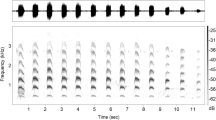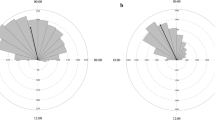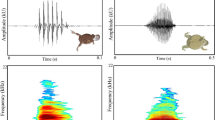Abstract
In anurans, vocalization is the primary communication form and acoustic parameters are influenced by climatic conditions, but also by social contexts. We investigated calling site use and within-individual variation of acoustic parameters throughout the night in the gladiator-frog Hypsiboas goianus. We expected that large males would call closer to the water and at higher perches to avoid dehydration and maximize sound propagation. Furthermore, we tested the prediction that males would emit more aggressive calls early in the night and more advertisement calls late at night. Male size was not correlated with either distance from the water or perch height. However, as expected, males of H. goianus adopted a calling strategy that consisted of emitting more aggressive calls early in the night and more advertisement calls later in the night. Furthermore, repetition rate and interval between notes of the aggressive calls and repetition rate of the advertisement calls showed within-individual variation throughout the night that agreed with our expectations. The calling strategy of H. goianus is probably related to the establishment of calling sites early in the night and an investment in female attraction in the middle of the night when males’ aggressive interactions have faded away, or due to habituation increasing the males’ aggressive thresholds. This is the first study investigating within-individual patterns of acoustic parameters of calls throughout the night for anurans.



Similar content being viewed by others
References
Abrunhosa PA, Wogel H (2004) Breeding behavior of the leaf-frog Phyllomedusa burmeisteri (Anura: Hylidae). Amphibia-Reptilia 25:125–135. doi:10.1163/1568538041231157
Alcantara MB, Lima LP, Bastos RP (2007) Breeding activity of Scinax centralis (Anura, Hylidae) in Central Brazil. Iheringia Sér Zool 97:406–410. doi:10.1590/S0073-47212007000400008
Aquiloni L, Gherardi F (2008) Assessing mate size in the red swamp crayfish Procambarus clarkii: effects of visual versus chemical stimuli. Freshw Biol 53:461–469. doi:10.1111/j.1365-2427.2007.01911.x
Bastos RP, Bueno MAF, Dutra SL, Lima LP (2003a) Padrões de vocalização de anúncio em cinco espécies de Hylidae (Amphibia: Anura) do Brasil Central. Comun Mus Ciênc Tecnol, PUCRS, Zool 16:39–51
Bastos RP, Motta JAO, Lima LP, Guimarães LD (2003b) Anfíbios da Floresta Nacional de Silvânia. Goiânia, Stylo gráfica e editora
Bastos RP, Alcantra MB, Morais AR, Lignau R, Signorelli L (2011) Vocal behaviour and conspecific call response in Scinax centralis (Anura: Hylidae). Herpetol J 21:43–50
Bee MA, Suyesh R, Biju SD (2013) Vocal behavior of the ponmudi bush frog (Raorchestes graminirupes): repertoire and individual variation. Herpetologica 69:22–35. doi:10.1655/HERPETOLOGICA-D-11-00042
Bee MA, Kozich CE, Blackwell KJ, Gerhardt HC (2001) Individual variation in advertisement calls of territorial male green frogs, Rana clamitans: implications for individual discrimination. Ethology 107:65–84. doi:10.1046/j.1439-0310.2001.00640.x
Bellis ED (1962) The influence of humidity on wood frog activity. Am Midl Nat 68:139–148. doi:10.2307/2422640
Berry FC, Breithaupt T (2010) To signal or not to signal? Chemical communication by urine-borne signals mirrors sexual conflict in crayfish BMC Biology 8. doi:10.1186/1741-7007-8-25
Bevier CR (1997) Utilization of energy substrates during calling activity in tropical frogs. Behav Ecol Sociobiol 41:343–352. doi:10.1007/s002650050394
Bourne GR (1993) Proximate costs and benefits of mate acquisition at leks of the frog Ololygon rubra. Anim Behav 45:1051–1059. doi:10.1006/anbe.1993.1131
Brooke PN, Alford RA, Schwarzkopf L (2000) Environmental and social factors influence chorusing behaviour in tropical frog: examining various temporal and spatial scale. Behav Ecol Sociobiol 49:79–87. doi:10.1007/s002650000256
Byrne PG (2008) Strategic male calling behavior in an Australian terrestrial toadlet (Pseudophryne bibronii). Copeia 2008:57–63. doi:10.1643/CE-05-294
Cinková I, Policht R (2015) Sex and species recognition by wild male southern white rhinoceros using contact pant calls. Anim Cogn 19:375–386. doi:10.1007/s10071-015-0940-7
Dias TM, Bastos RP, Siqueira MN, Morais AR (2014a) The release call of Hypsiboas goianus (B. Lutz, 1968) (Anura: Hylidae) from Central Brazil. Herpetol Notes 7:215–217
Dias TM, Maragno FP, Prado CPA, Cechin SZ (2014b) Reproductive site selection in the leaf-frog Phyllomedusa azurea (Anura: Hylidae) in altered areas of the Brazilian Cerrado. J Nat Hist 48:43–44. doi:10.1080/00222933.2014.896486
Faivovich J, Haddad CFB, Garcia PCA, Frost DR, Campbell JA, Wheeler WC (2005) Systematic review of the frog family Hylidae, with special reference to Hylinae: phylogenetic analysis and taxonomic revision. B Am Mus Nat Hist 294:12–40. doi:10.1206/0003-0090(2005)294[0001:SROTFF]2.0.CO;2
Frost DR [internet] c1998–2016. Amphibian Species of the World. [cited 2016 May 15] Available from: http://research.amnh.org/herpetology/amphibia/index.html.
Gambale PG, Bastos RP (2014) Vocal repertoire and bioacoustic analyses in Physalaemus cuvieri (Anura, Leptodactylidae) from southern Brazil. Herpetol J 24:31–39
Given MF (1987) Vocalizations and acoustic interactions of the carpenter frog, Rana virgatipes. Herpetologica 43:467–481
Guimarães LD, Lima LP, Juliano RF, Bastos RP (2001) Vocalizações de espécies de anuros (Amphibia) no Brasil Central. Bol Mus Nac, NS, Zool, Rio de Janeiro 474:1–14
Heavener SJ, Carthey AJR, Banks PB (2014) Competitive naïveté between a highly successful invader and a functionally similar native species. Oecologia 175:73–84
Herberholz J, McCurdy C, Edwards DH (2007) Direct benefits of social dominance in juvenile crayfish. Biol Bull 213:21–27
Howard RD (1978) The influence of male-defended oviposition sites on early embryo mortality in bullfrogs. Ecology 59:789–798. doi:10.2307/1938783
Huberty CJ, Morris JD (1989) Multivariate analysis versus multiple univariate analyses. Psychol Bull 105:302–308. doi:10.1037/0033-2909.105.2.302
Kime NM, Turner WR, Ryan MJ (1999) The transmission of advertisement calls in central American frogs. Behav Ecol 11:71–83. doi:10.1093/beheco/11.1.71
Lemckert FL, Slatyer C (2002) Short-term movements and habitat use of the green-thighed frog, Litoria brevipalmata (Anura: Hylidae). Aust Zool 32:56–61. doi:10.7882/AZ.2002.005
Lemes P, Tessarolo G, Morais AR, Bastos RP (2012) Acoustic repertoire of Barycholos ternetzi (Anura: Strabomantidae) in central Brazil. South Am J Herpetol 7:157–164. doi:10.2994/057.007.0205
Licht LE (1976) Sexual selection in toads (Bufo americanus). Can J Zool 54:1277–1284. doi:10.1139/z76-145
Lignau R, Bastos RP (2007) Vocalizations of the Brazilian torrent frog Hylodes heyeri (Anura: Hylodidae): repertoire and influence of air temperature on advertisement call variation. J Nat Hist 41:1227–1235. doi:10.1080/00222930701395626
Llusia D, Gómez M, Penna M, Márquez R (2013) Call transmission efficiency in native and invasive anurans: competing hypotheses of divergence in acoustic signals. PLoSOne 8:1–16. doi:10.1371/journal.pone.0077312
Marshall VT, Humfeld SC, Bee MA (2003) Plasticity of aggressive signaling and its evolution in male spring peepers, Pseudacris crucifer. Anim Behav 65:1223–1234. doi:10.1006/anbe.2003.2134
McGregor PK, Peake TM (2000) Communication networks: social environments for receiving and signalling behaviour. Acta ethol 2:71–81. doi:10.1007/s102110000015
Menin M, Silva RA, Giaretta AA (2004) Reproductive biology of Hyla goiana (Anura, Hylidae). Iheringia, Sér Zool 94:49–52. doi:10.1590/S0073-47212004000100008
Morais AR, Batista VG, Gambale PG, Signorelli L, Bastos RP (2012) Acoustic communication in a Neotropical frog (Dendropsophus minutus): vocal repertoire, variability, and individual discrimination. Herpetol J 22:249–257
Morais AR, Siqueira MN, Márquez R, Bastos RP (2015) Males of Hypsiboas goianus (Anura; Hylidae) do not assess neighbor fighting ability through acoustic interactions. Acta Ethol 19:43–50. doi:10.1007/s10211-015-0221-0
Morris MR, Yoon SL (1989) A mechanism for female choice of large males in the treefrog Hyla chrysoscelis. Behav Ecol Sociobiol 25:65–71. doi:10.1007/BF00299712
Murphy CG (1999) Nightly timing of chorusing by male barking treefrogs (Hyla gratiosa): the influence of female arrival and energy. Copeia 2:333–347. doi:10.2307/1447479
Nali RC, Prado CPA (2012) Habitat use, reproductive traits and social interactions in stream-dweller treefrog endemic to the Brazilian Cerrado. Amphibia-Reptilia 33:337–347. doi:10.1163/15685381-00002836
Pauly GB, Bernal XE, Rand AS, Ryan MJ (2006) The vocal sac increases call rate in the Túngara frog Physalaemus pustulosus. Physiol Biochem Zool 79:708–719. doi:10.1086/504613
Pékar S, Brabec M (2016) Marginal models via GLS: a convenient yet neglected tool for the analysis of correlated data in the behavioural sciences. Ethology 122:1–11. doi:10.1111/eth.12514
Pettitt BA, Bourne GR, Bee MA (2013) Advertisement call variation in the golden rocket frog (Anomaloglossus beebei): evidence for individual distinctiveness. Ethology 119:244–256. doi:10.1111/eth.12058
Pfenning KS (2000) Female spadefoot toads compromise on mate quality to ensure conspecific matings. Behav Ecol 11:220–227. doi:10.1093/beheco/11.2.220
R Development Core Team (2013) R: a language and environment for statistical computing. R Foundation for Statistical Computing, Vienna. http://www.Rproject.org/
Reichert MS (2010) Aggressive thresholds in Dendropsophus ebraccatus: habituation and sensitization to different call types. Behav Ecol Sociobiol 64:529–539. doi:10.1007/s00265-009-0868-5
Rogers TL, Cato DH (2002) Individual variation in the acoustic behaviour of the adult male leopard seal, Hydrurga leptonyx. Behaviour 139:1267–1286
Runkle LS, Wells KD, Robb CC, Lance SL (1994) Individual, nightly and seasonal variation in calling behavior in the gray treefrog, Hyla versicolor: implications for energy expenditure. Behav Ecol 5:318–325. doi:10.1093/beheco/5.3.318
Ryan MJ (1988) Constraints and patterns in the evolution of anuran acoustic communication. In: Fritzsch B, Hethington T, Ryan M, Wilczynski W, Walkowiak W (eds) The evolution of the amphibian auditory system. John Wiley, New York, pp 637–677
Ryan MJ (1991) Sexual selection and communication in frogs. Trends Ecol Evol 6:351–354. doi:10.1016/0169-5347(91)90224-L
Schwartz JJ, Buchanan BW, Gerhardt HC (2002) Acoustic interactions among male gray treefrogs, Hyla versicolor, in a chorus setting. Behav Ecol Sociobiol 53:9–19. doi:10.1007/s00265-002-0542-7
Shepard DB (2004) Seasonal differences in aggression and site tenacity in male green frogs, Rana clamitans. Copeia 2004:159–164
Steelman CK, Dorcas ME (2010) Anuran calling survey optimization: developing and testing predictive models of anuran calling activity. J Herpetol 44:61–68. doi:10.1670/08-329.1
Tárano Z, Fuenmayor E (2013) Mate choice based on acoustic features in Johnstone’s whistling frog Eleutherodactylus johnstonei: an experimental approach. South Am J Herpetol 8:52–59. doi:10.2994/SAJH-D-12-00016.1
Thompson RF, Spencer WA (1966) Habituation: a model phenomenon for the study of neuronal substrates of behavior. Psychol Rev 73:16–43
Toledo LF, Martins IA, Bruschi DP, Passos MA, Alexandre C, Haddad CFB (2015) The anuran calling repertoire in the light of social context. Acta Ethol 18:87–99. doi:10.1007/s10211-014-0194-4
Vidal WN, Vidal MRR (2003) Botânica organografia: quadros sinóticos ilustrados de fanerógamos. UFV, Viçosa
Wagner WE (1989) Social correlates in male calling behavior in Blanchard’s cricket frog, Acris crepitans blanchardi. Ethology 82:27–45. doi:10.1111/j.1439-0310.1989.tb00485.x
Welch AM, Semlitsch RD, Gerhardt HC (1998) Call duration as an indicator of genetic quality in male gray tree frogs. Science 280:1928–1930. doi:10.1126/science.280.5371.1928
Wells KD (1977) The social behaviour of anuran amphibians. Anim Behav 25:666–693. doi:10.1016/0003-3472(77)90118-X
Wells KD (1978) Territoriality in the green frog (Rana clamitans): vocalizations and agonistic interactions. Anim Behav 26:1051–1063. doi:10.1016/0003-3472(78)90094-5
Wells KD (2001) The energetic of calling in frogs. In: Ryan MJ (ed) Anuran communication. Smithsonian Institution Press, Washington, pp 45–60
Wells KD (2007) The ecology and behavior of amphibians. University of Chicago Press, Chicago
Wells KD, Schwartz JJ (1982) The effect of vegetation on the propagation of calls in the Neotropical frog Centrolenella fleischmanni. Herpetologica 38:449–455
Wogel H, Abrunhosa PA, Pombal JP Jr (2002) Atividade reprodutiva de Physalaemus signifer (Anura, Leptodactylidae) em ambiente temporário. Iheringia, Sér Zool 92:57–70. doi:10.1590/S0073-47212002000200006
Zar JH (1999) Biostatistical analysis. Prentice Hall, New Jersey
Acknowledgements
We acknowledge the CNPq (Conselho Nacional de Desenvolvimento Científico e Tecnológico, # 476800/2011-0) and ICMBio (Instituto Chico Mendes de Conservação da Biodiversidade) for financial support. R.P. Bastos is grateful to CNPq (# 304363/2010-3) and T.M. Dias to CAPES (Coordenação de Aperfeiçoamento de Pessoal de Nível Superior) for fellowships. C.P.A. Prado acknowledges the São Paulo Research Foundation (FAPESP #2009/12013-4), for financial support, and CNPq (#301125/2013-9), for research fellowship. ICMbio for the collecting permit (#40668-1). We thank P. de Marco Jr. for the help with statistical analyses, P. Nobre, A.R. Morais, and M.N. Siqueira for the help with the fieldwork, and M.M. Dalosto for the valuable suggestions on the manuscript. We specially thank V.T.T. de Sousa for the help with fieldwork, statistical analyses, and for valuable insights.
Author information
Authors and Affiliations
Corresponding author
Rights and permissions
About this article
Cite this article
Dias, T.M., Prado, C.P.A. & Bastos, R.P. Nightly calling patterns in a Neotropical gladiator frog. acta ethol 20, 207–214 (2017). https://doi.org/10.1007/s10211-017-0263-6
Received:
Revised:
Accepted:
Published:
Issue Date:
DOI: https://doi.org/10.1007/s10211-017-0263-6




